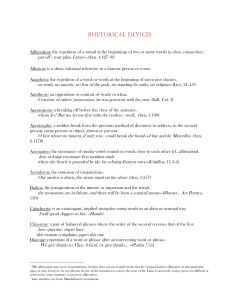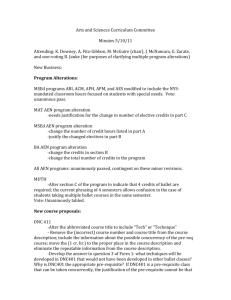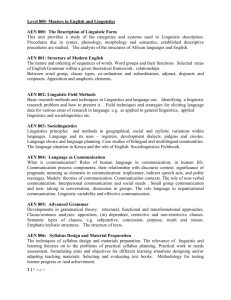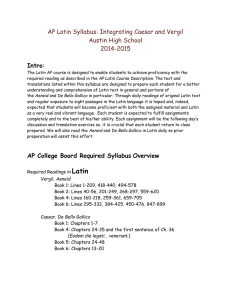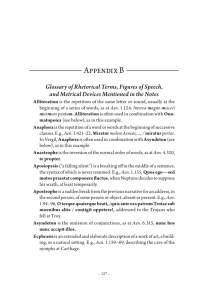BACHELOR OF EDUCATION AND BACHELOR OF ARTS Level 100
advertisement
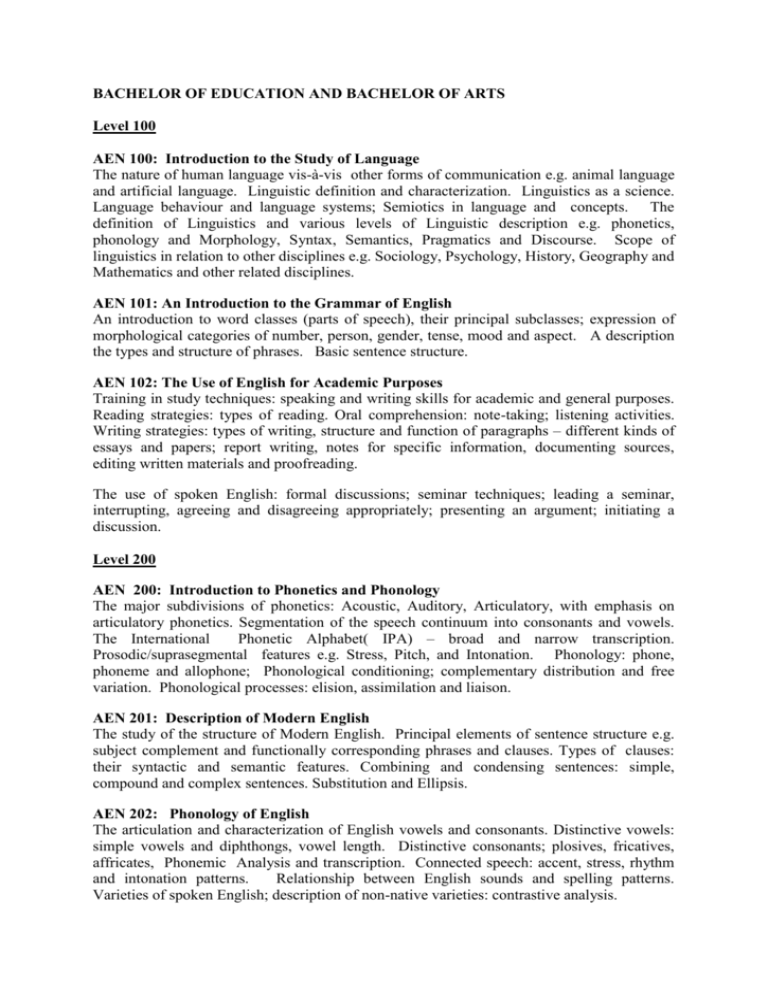
BACHELOR OF EDUCATION AND BACHELOR OF ARTS Level 100 AEN 100: Introduction to the Study of Language The nature of human language vis-à-vis other forms of communication e.g. animal language and artificial language. Linguistic definition and characterization. Linguistics as a science. Language behaviour and language systems; Semiotics in language and concepts. The definition of Linguistics and various levels of Linguistic description e.g. phonetics, phonology and Morphology, Syntax, Semantics, Pragmatics and Discourse. Scope of linguistics in relation to other disciplines e.g. Sociology, Psychology, History, Geography and Mathematics and other related disciplines. AEN 101: An Introduction to the Grammar of English An introduction to word classes (parts of speech), their principal subclasses; expression of morphological categories of number, person, gender, tense, mood and aspect. A description the types and structure of phrases. Basic sentence structure. AEN 102: The Use of English for Academic Purposes Training in study techniques: speaking and writing skills for academic and general purposes. Reading strategies: types of reading. Oral comprehension: note-taking; listening activities. Writing strategies: types of writing, structure and function of paragraphs – different kinds of essays and papers; report writing, notes for specific information, documenting sources, editing written materials and proofreading. The use of spoken English: formal discussions; seminar techniques; leading a seminar, interrupting, agreeing and disagreeing appropriately; presenting an argument; initiating a discussion. Level 200 AEN 200: Introduction to Phonetics and Phonology The major subdivisions of phonetics: Acoustic, Auditory, Articulatory, with emphasis on articulatory phonetics. Segmentation of the speech continuum into consonants and vowels. The International Phonetic Alphabet( IPA) – broad and narrow transcription. Prosodic/suprasegmental features e.g. Stress, Pitch, and Intonation. Phonology: phone, phoneme and allophone; Phonological conditioning; complementary distribution and free variation. Phonological processes: elision, assimilation and liaison. AEN 201: Description of Modern English The study of the structure of Modern English. Principal elements of sentence structure e.g. subject complement and functionally corresponding phrases and clauses. Types of clauses: their syntactic and semantic features. Combining and condensing sentences: simple, compound and complex sentences. Substitution and Ellipsis. AEN 202: Phonology of English The articulation and characterization of English vowels and consonants. Distinctive vowels: simple vowels and diphthongs, vowel length. Distinctive consonants; plosives, fricatives, affricates, Phonemic Analysis and transcription. Connected speech: accent, stress, rhythm and intonation patterns. Relationship between English sounds and spelling patterns. Varieties of spoken English; description of non-native varieties: contrastive analysis. AEN 203: Morphology, Syntax and Semantics Linguistic principles which govern the analysis, description, classification and comparison of particular language structures. Word systems (morphology), phrase and sentence systems (syntax) and meaning (semantics), sense relations: synonymy hyponymy; antonymy, polysemy and homophony. COURSE DESCRIPTION Level 300 AEN 300: Phonetic and Phonological Analysis Alternative approaches to phonetic and phonological analysis: Segmental and parametric approaches. Phonological features in language. The notions of articulatory and phonatory setting. The role of prosodic categories: syllable, stress, pitch, intonation and rhythm. AEN 301: Discourse Analysis The nature of spoken and written discourse. The relationship between linguistic form, discourse function and interpretation of contextual features in the creation an interpretation of discourse. Topic and information structure. The notions of theme and rheme, given and new speech Acts. Units of discourse. Practical analysis. The creation and interpretation of cohesion and coherence in spoken and written discourse. AEN 302: English Grammar and Usage A detailed study of selected areas of English grammar and usage. The notion of determiner and the usage of the various types: predeterminers, central –determiners, post-determiners. Transitivity and intransitivity of verbs and passivization. Finite and non-finite verb usage. Form and function of auxiliary verbs: primary and modal. Agreement Distinctions between prepositional and conjunctional usage of some function words. The participle. Distinction between adverbial and adjectival usage. Case in English. AEN 303: Second Language Acquisition The notion of applied linguistics in relation to language teaching and learning/acquisition. Theoretical perspectives: Behaviourism; Constrastive analysis; Error Analysis; mentalist perspectives; Innateness, Universal hypothesis. Interlanguage: The Monitor and Acculturation models; The role of formal instruction and age of the learner in language acquisition. The internal processing theories; the performance analysis, form and interpretation of interlingual constructions. Implications of an interlanguage for pedagogy. AEN 306: Psycholinguistics Interrelation between language and psychology. The acquisition of language in children: its form, organization, function and interpretation. Interrelation between language, brain and thought. Perception and information processing: Perception of sentences and clausal boundaries. Parsing strategies: e.g. Top-down; left right association and new nodes. Language disorder; aphasia, dyslexia and lisping. AEN 307: Research Methods in Linguistics Conducting research on language : identifying a researchable linguistic topic; reviewing literature related to a linguistic research problem. Stating a linguistic research problem ; formulating appropriate research questions and stating the relevant assumptions/ hypotheses; specify the variables in linguistic research : language variables; social variables and other variables. Determination of sample size and characteristics; methods of collecting, processing, presenting and analyzing linguistic data. Writing a linguistic research report: chapterization, documentation styles. Font and back matter of the report. AEN 310: Origins and Development of English The notion of language families and language change: origins, development and spread of the English language in both commonwealth and non-commonwealth countries. English in Kenya: origins, development and spread. AEN 311: Language and Speech Disorders Language and speech disorders emanating from psychological and neurological problems. Developmental and emotional problems: stuttering/stammering and resonance. Perspective and expressive disorders. Disorders in articulation, phonation, and in the morphological, lexical and syntactic systems. Disorders of aphasia, alexia and dyslexia and dyslexia. Aspects of language loss and language atrophy. Level 400 COURSE DESCRIPTION AEN 400: Advanced Theoretical Studies in Grammar An advanced study of syntax and morphology through the application of Generative Grammar and Systematic Functional Grammar. Detailed study of morphology. AEN 401: Varieties of English The notion of standard English. General Criteria for standardization. Contrast between British and any other native Englishes. English as a second, foreign and international language. Variation in English according to: education, topic, medium and attitude. The notion of localized forms of English, e.g. Chinese, Indian, Caribbean, Nigerian and Kenyan English . Institutionalized English varieties and the development of creoles and pidgins from English. AEN 402: English Semantics and Pragmatics Semantic and pragmatic characteristics of modern English. The representational components of meaning morpheme; word; sentence; text. Types of meaning: conceptual, connotative and social. The clause (simple sentence) and the representation of processes and associated structural and contextual functions, such as agent, patient, commutative, benefit view, theme, rheme. Paratactic and hypotactic structures, semantic relations. The speech act. The speech situation: the speaker’s intuition, modality, comment and attitude. AEN 403: Sociolinguistics Interaction of Language and society. Language in developing nations: bilingualism and multilingualism. Language in Kenya (the sociolinguistic Geography of Kenya) Sociolinguistic implications of multilingualism in East Africa: National and regional language policies; standard and official language; Language and human interaction. The speech community: idiolect, dialect, languages in contact. Variables in language behaviour and linguistic variation. Interaction of language and culture, the Sapir-Whorf hypothesis. An introduction to sociolinguistic fieldwork. AEN 405: Functional Grammar Introduction to Functional Grammar. Various models of functionalism, Prague school, Dik’s functionalism and Hallidayan Grammar. Methodological principles, functional grammar compared to other schools of Grammar, such as generative grammar. Practical analysis of texts. AEN 406: Socio-Psychology of Language and Communication Perspectives of intra- group communication. The effects of age, sex, and social class on intragroup and inter- group communication. The essential elements in communication: source, channel, message, referent and receiver. Coding and decoding. Social cognition (Social and social stereotypes) and inter-group communication rules in social networks. AEN 407: Linguistic Typology and Language Classification Classification of languages according to structural and geneological types. Approaches in the classification of African Languages. The phenomena of borrowing, wave-theory and the factors influencing them. The glottochronological study of related languages. AEN 409: Research Project (2 Units) With the guidance of the supervisor, a B.A. English Major student will select a suitable research topic on an aspect of language. The student will carry out the necessary fieldwork and present a dissertation.

